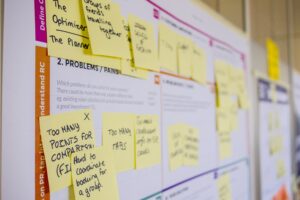Among the BMC’s nine essential building blocks, the Key Resources segment often doesn’t get the spotlight it deserves. It is this crucial component that forms the backbone of the business, underpinning every other block from value propositions to customer relationships. In today’s post, we delve into the fascinating world of the Key Resources block, unraveling its significance, how it intertwines with the other elements of the BMC, and why understanding it is indispensable to crafting a successful business strategy.
What Are Key Resources and Why Do They Matter?
Key Resources, as identified within the Business Model Canvas, are the foundational assets that businesses require to create and deliver value to customers. These resources serve as the backbone of a successful business model, enabling efficient and effective operations throughout various dimensions.
Physical resources refer to the tangible assets that a business requires to operate, such as machinery, equipment, and office space. These resources are critical to the production process and can have a significant impact on a company’s bottom line.
Intellectual resources, on the other hand, refer to intangible assets like patents, copyrights, and trademarks. These resources are essential for protecting a company’s ideas and innovations, and can help to differentiate a business from its competitors.
Human resources are another key resource that businesses need to consider. This includes the skills, knowledge, and experience of the people who work for the company. Having the right people in the right roles can make a huge difference in a company’s success.
Finally, financial resources refer to the money that a business has available to invest in its operations. This includes sources of funding like loans, investments, and revenue from sales. Managing these resources effectively is essential for ensuring the long-term viability of a business.
Recognizing, identifying, and managing these Key Resources within the Business Model Canvas is essential for reducing costs, enhancing operational efficiency, and ultimately improving profitability. A thorough understanding of the resources required for effective business operations empowers strategic decision-making, facilitating the achievement of goals and fostering sustained growth over time.
Types of Key Resources
Key Resources are the backbone of any successful business. They are the essential components that a company needs to create and deliver its products or services. As mentioned, Key Resources can be divided into several categories. Here are some of the most common types:
Physical Resources
Physical Resources are the tangible assets that a company needs to produce or deliver its products or services. These resources include machines, equipment, buildings, and materials. For example, a bakery needs ovens, mixers, and baking pans to make bread and pastries. A construction company needs bulldozers, cranes, and cement mixers to build houses and buildings.
Intellectual Resources
Intellectual Resources are the intangible assets that a company needs to protect its products or services. These resources include patents, trademarks, and copyrights, as well as proprietary software and data. For example, a software company needs to protect its code with patents and copyrights to prevent others from copying it.
Human Resources
Human Resources are the people who work for a company and provide the expertise and skills needed to create and deliver its products or services. These resources include employees, contractors, and freelancers. For example, a marketing agency needs writers, designers, and social media experts to create and implement marketing campaigns.
Financial Resources
Financial Resources are the funds that a company needs to start and run its business, pay its expenses, and invest in growth opportunities. These resources include funding, investments, and capital. For example, a startup needs funding from investors to develop its product and bring it to market. A mature company needs capital to expand into new markets or acquire other companies.
In conclusion, Key Resources are essential for any business to succeed. They provide the foundation for creating and delivering products or services, protecting intellectual property, and growing the company. By understanding the different types of Key Resources, a company can make better decisions about how to allocate its resources and achieve its goals.
How to Find Key Resources
Identifying your Key Resources involves conducting a thorough analysis of your business operations and processes. Start by looking at each of the categories above and evaluating which resources are essential for the success of your business.
For example, if you are running an online retail store, one of your key resources would be your website. Your website is the face of your business and the main platform where customers can browse and purchase your products. Another key resource for an online retail store would be the inventory management system. Without an efficient system in place, it would be difficult to keep track of your stock levels and ensure that you have enough products to meet customer demand.
To do this, you can use different tools and techniques, such as a SWOT analysis, a value chain analysis or a competitive analysis. A SWOT analysis can help you identify your business’s strengths, weaknesses, opportunities, and threats. A value chain analysis can help you identify all the activities involved in delivering your product or service to the customer, and how you can add value at each stage. A competitive analysis can help you understand your competition and how you can differentiate yourself from them.
Once you’ve identified your Key Resources, prioritize them according to their importance in your business and evaluate how efficient you are in utilizing these resources. Are you maximizing your use of your Key Resources? For example, if your key resource is your website, are you regularly updating it with new content and optimizing it for search engines? Are there any gaps in your resources that you need to fill? These questions can help you develop a clear plan for managing and optimizing your Key Resources.
Another key resource for an online retail store would be your customer service team. Your customer service team is the main point of contact between your business and your customers. They handle inquiries, complaints, and provide support to ensure that customers have a positive experience with your business. Investing in your customer service team can help you build a loyal customer base and differentiate yourself from your competitors.
Finally, it’s important to regularly review and update your Key Resources. As your business grows and evolves, your Key Resources may change. Regularly reviewing and updating your Key Resources can help you stay competitive and ensure that you are always maximizing your resources.
Examples of Key Resources
Here are some examples of Key Resources from different industries:
- Apple: Intellectual property in the form of patents, trademarks, and proprietary software.
- Amazon: Advanced data analytics capabilities and a vast network of distribution centers and warehouses
- McDonald’s: A global network of franchisees, its unique food-preparation process, and its brand recognition.
- Ritz-Carlton: Employee training programs and high-quality customer service.
Conclusion
By identifying and managing your Key Resources effectively in conjunction with the other sections of the Business Model Canvas, you can ensure that your business is positioned for success. Take the time to analyze your business model, identify your Key Resources, and develop a plan to optimize their use. Doing so will help you to operate your business more efficiently, create value for your customers, and achieve your goals.








